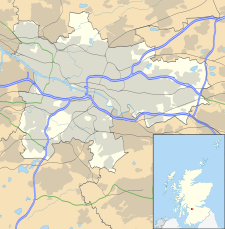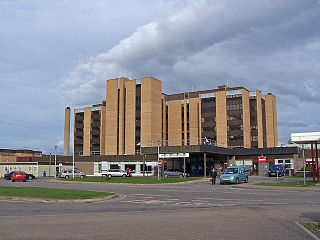
Raigmore Hospital is a health facility located in Inverness, Scotland. It serves patients from the local area as well as providing specialist services to patients from across the Highland area. It is a teaching hospital, educating a range of healthcare professionals in association with the Universities of Aberdeen and Stirling. It is managed by NHS Highland.

The Princess Royal Maternity Hospital is a maternity hospital in Glasgow, Scotland. It was founded as the Glasgow Lying-in Hospital and Dispensary in 1834 in Greyfriars Wynd, just off the city's High Street. It moved to St Andrew's Square in 1841, then to Rottenrow in 1860 and to the Glasgow Royal Infirmary site in 2001. It is managed by NHS Greater Glasgow and Clyde.
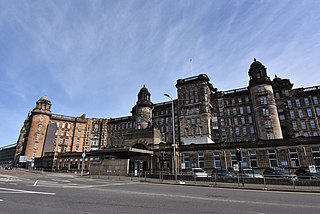
The Glasgow Royal Infirmary (GRI) is a large teaching hospital. With a capacity of around 1,000 beds, the hospital campus covers an area of around 8 hectares, and straddles the Townhead and Dennistoun districts on the north-eastern fringe of the city centre of Glasgow, Scotland. It is managed by NHS Greater Glasgow and Clyde. It was originally opened in 1794, with the present main building dating from 1914.
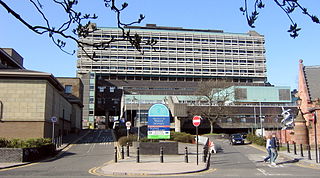
The Western Infirmary was a teaching hospital situated in Yorkhill in the West End of Glasgow, Scotland, that was managed by NHS Greater Glasgow and Clyde. It was opened in 1874 and closed in 2015.

The Royal Infirmary of Edinburgh (RIE), often known as the Edinburgh Royal Infirmary (ERI), was established in 1729 and is the oldest voluntary hospital in Scotland. The new buildings of 1879 were claimed to be the largest voluntary hospital in the United Kingdom, and later on, the Empire. The hospital moved to a new 900 bed site in 2003 in Little France. It is the site of clinical medicine teaching as well as a teaching hospital for the University of Edinburgh Medical School. In 1960, the first successful kidney transplant performed in the UK was at this hospital. In 1964, the world's first coronary care unit was established at the hospital. It is the only site for liver, pancreas and pancreatic islet cell transplantation and one of two sites for kidney transplantation in Scotland. In 2012, the Emergency Department had 113,000 patient attendances, the highest number in Scotland. It is managed by NHS Lothian.

NHS Scotland, sometimes styled NHSScotland, is the publicly–funded healthcare system in Scotland and one of the four systems that make up the National Health Service in the United Kingdom. It operates 14 territorial NHS boards across Scotland, supported by seven special non-geographic health boards, and Public Health Scotland.

Leeds General Infirmary, also known as the LGI, is a large teaching hospital based in the centre of Leeds, West Yorkshire, England, and is part of the Leeds Teaching Hospitals NHS Trust. Its previous name The General Infirmary at Leeds is still sometimes used.

NHS Greater Glasgow and Clyde is an NHS board in West Central Scotland, created from the amalgamation of NHS Greater Glasgow and part of NHS Argyll and Clyde on 1 April 2006.

The West Glasgow Ambulatory Care Hospital is a healthcare facility in Yorkhill, Glasgow. The new ambulatory care facility was created in December 2015 to house the remaining outpatient services and the minor injury unit previously housed at the Western Infirmary. It is managed by NHS Greater Glasgow and Clyde.

Stobhill Hospital is located in Springburn in the north of Glasgow, Scotland. It serves the population of North Glasgow and part of East Dunbartonshire. It is managed by NHS Greater Glasgow and Clyde.

Ninewells Hospital is a large teaching hospital, based on the western edge of Dundee, Scotland. It is internationally renowned for introducing laparoscopic surgery to the UK as well as being a leading centre in developing fields such as the management of cancer, medical genetics and robotic surgery. Within the UK, it is also a major NHS facility for psychosurgery. The medical school was ranked first in the UK in 2009. The hospital has nursing and research links with the University of Dundee and is managed by NHS Tayside.

Gartnavel Royal Hospital is a mental health facility based in the west end of Glasgow, Scotland. It provides inpatient psychiatric care for the population of the West of the City. It used to house the regional adolescent psychiatric unit but this has recently moved to a new psychiatric unit at Stobhill Hospital. The Hospital is a venue used by the Mental Health Tribunal for Scotland. Some parts of the hospital are classified as a category A building and are also deemed at risk.
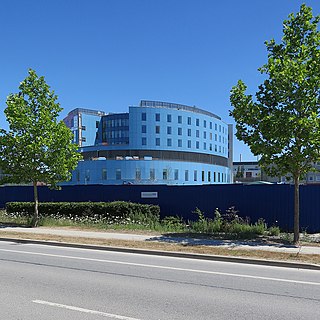
Royal Papworth Hospital is a specialist heart and lung hospital, located on the Cambridge Biomedical Campus in Cambridgeshire, England. The Hospital is run by Royal Papworth Hospital NHS Foundation Trust.

Gartnavel General Hospital is a teaching hospital in the West End of Glasgow, Scotland. The hospital is located next to the Great Western Road, between Hyndland, Anniesland and Kelvindale. Hyndland railway station is adjacent to the hospital. The name Gartnavel is derived from the Gaelic GartUbhal (apple) – i.e. "a field of apple trees". It is managed by NHS Greater Glasgow and Clyde.

The Royal Alexandra Hospital (RAH) is the main hospital in Paisley serving a large catchment area stretching all the way to Oban and Argyll. The hospital is managed by NHS Greater Glasgow and Clyde.
Dame Anna Felicja Dominiczak DBE FRCP FRSE FAHA FMedSci is a Polish-born British medical researcher, Regius Professor of Medicine - the first woman to hold this position, and the Chief Scientist (Health) for the Scottish Government. From 2010 to 2020, Dominiczak was the Vice-Principal and Head of the College of Medical, Veterinary and Life Sciences at the University of Glasgow, Scotland. She is an Honorary Consultant Physician and Endocrinologist for the NHS Greater Glasgow and Clyde Health Board, and Health Innovation Champion for the Medical Research Council. From 2013 to 2015, Dominiczak was president of the European Society of Hypertension. She is the current Editor-in-Chief of Precision Medicine, a new journal launched in July 2023.

The Southern General Hospital (SGH) was a large teaching hospital with an acute operational bed complement of approximately 900 beds. The hospital was located in Linthouse in the south west of Glasgow, Scotland. All facilities and services have been succeeded by the Queen Elizabeth University Hospital which was constructed on the site of the old hospital.

The Glasgow Victoria Infirmary was a teaching hospital situated at Langside/Battlefield in the south-east of Glasgow from 1880 until 2015. It was managed by NHS Greater Glasgow and Clyde.

Forth Valley Royal Hospital is a hospital located in Larbert, Scotland. With 860 inpatient beds, 25 wards, and 16 operating theatres, it was Scotland's largest ever NHS construction project at the time but has been surpassed by the New Southern General hospital amongst others. Built at a cost of £300 million on the site of the old Royal Scottish National Hospital, it opened to its first patients in 2010. It is operated by NHS Forth Valley.
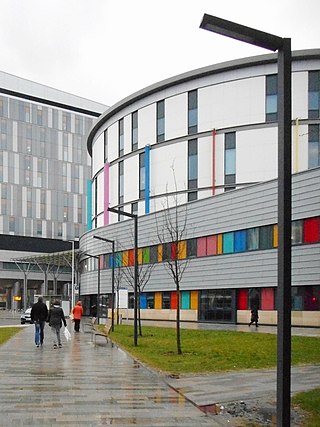
The Royal Hospital for Children is a 256-bed hospital specialising in paediatric healthcare for children and young people up to the age of 16. The hospital is part of the Queen Elizabeth University Hospital and is built on the site of the former Southern General Hospital, in Govan and opened in June 2015. The hospital replaced the Royal Hospital for Sick Children in Yorkhill. It is managed by NHS Greater Glasgow and Clyde.


